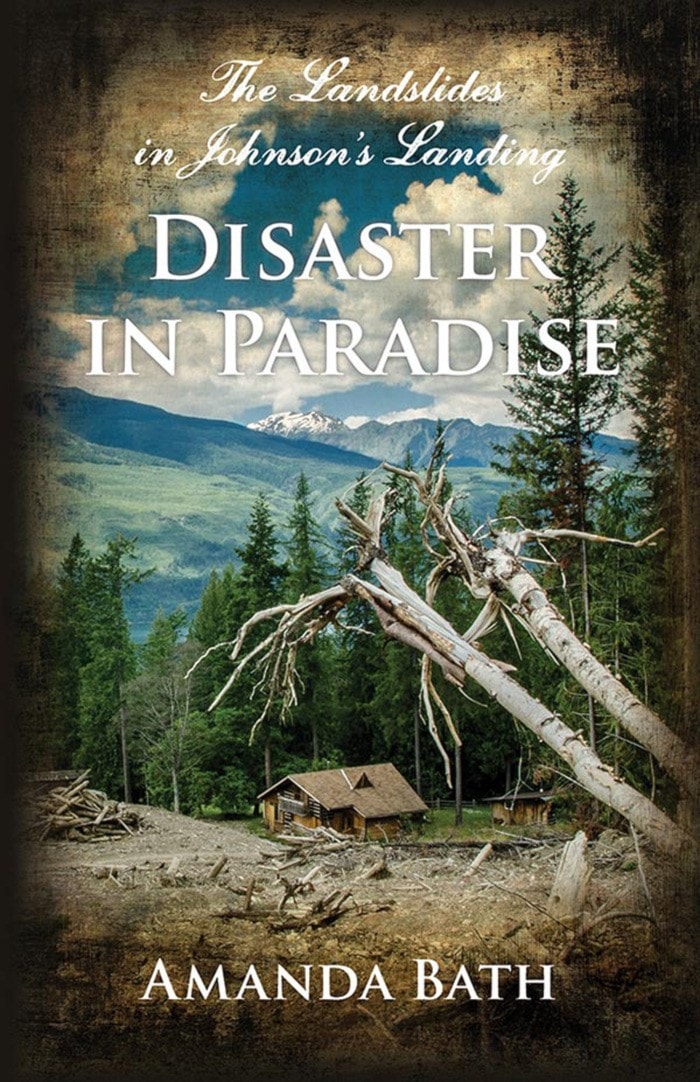“The afternoon found me in my place on the lounger by the corner post when I noticed something odd. A coffee-coloured slick, a brown ribbon about half a metre wide, had suddenly appeared along the lakeshore, emanating from the mouth of Gar Creek…The water was the colour of well-brewed tea…Then the smell hit me—earthy, dank, with a tinge of something like pine disinfectant, wafting down from the creek draw. Obviously the odour indicated broken and smashed pine trees up above us, but what else was going on?”
-Mandy Bath, Disaster in Paradise
As I stood underneath Kootenay Joe Ridge with Johnson’s Landing survivor Mandy Bath on Sunday afternoon, it struck me that this was one of the first environmental disasters I’d ever seen up close.
Though of course I paid attention to the media coverage of Toronto’s recent ice storm, Calgary’s devastating flood and the epic destruction of Hurricane Sandy, I was still experiencing Earth’s occasionally deadly tantrums from the opposite side of a screen.
But here I could actually lean over and touch the jagged chunks of broken rock and the slope-swept detritus left by the landslide. I knew somewhere below my feet were three unrecovered bodies.
“What happened in Johnson’s Landing is unprecedented in modern times,” Bath told me. “It was a combination of extreme weather in June 2012, mixed with a heatwave of over 30 degrees centigrade, while meanwhile we had 125 per cent of the normal snowpack.”
One would think there would have been a system in place to read these warning signs, or some plan in case disaster struck. But Johnson’s Landing had neither.
“We were all in denial,” she said.
PAYING ATTENTION
While we chatted about her memoir Disaster in Paradise, which recounts her experiences in the Johnson’s Landing slide, I asked Bath whether she’d heard of the recently released book Waking the Frog by entrepreneur Tom Rand.
Only weeks before Nelson city council had re-arranged their meeting to see Rand speak, and I was halfway through a copy that had been loaned to me by a community member.
She hadn’t read it, but was in agreement with the gist of Rand’s climate disruption message: like the pot-warmed frog in the classic story, human beings are not cluing in to the increasing warning signs that our Earth is in trouble.
According to both Rand and Bath, if we don’t do something soon we may end up amidst the rubble, just like her, wondering how we got there.
She noted that since the disaster there have been some encouraging developments, such as the Regional District of Central Kootenay distributing information pamphlets to assist rural residents in recognizing environmental warning signs.
Positive steps like this will continue, she hopes. But there’s still a long way to go.
In her book she quotes John Kettle: “In my opinion we can and must do better than this. Additionally, with the apparent climate change, this may very well be just the beginning of adverse weather related events throughout the province. God helps us if we don’t learn and adapt from the Johnson’s Landing disaster.”
Kettle later argued for new provincial legislation to establish a BC Disaster Relief Fund, which has yet to come to fruition.
And though the evacuation order has been lifted, the residents are still dealing with the consequences years later.
As Andy Shadrack put it “the provincial government has absolutely failed the people of Johnson’s Landing.”
A COMMUNITY RECORD
As I read through Disaster in Paradise, I routinely busted out my highlighter whenever I reached a name I recognized.
My predecessor at the Star, Meghan Cole, makes an appearance. So does former city councillor Donna Macdonald, Nelson-Creston MLA Michelle Mungall and reporter Bob Keating. And it’s this immediacy that made the narrative so gut-level compelling.
You’re not reading about strangers, but people who live in your midst. And you’re not reading about a faraway place, like tsunami-ravaged Thailand, but a little community only an hour’s drive away.
Though the lion’s share of the narrative is given over to Bath’s recollections, she has also made plentiful space within the book for others to share their story.
In this way the book approaches a universality it might have lacked otherwise, showing the event from multiple points of view.
In two chapters, “Those Who Were There” and “Those Who Came”, she generously gives over the page to her subjects, letting them recount their experiences in their own words. The fact that she was capable of doing this massive amount of work—all while relocating to Kaslo and going through her own, unique emotional upheaval—is inspiring.
Illustrated with 24 pages of full-colour photos, Paradise does an excellent job of establishing the spirit of Johnson’s Landing and is a moving tribute to the four people who lost their lives there: Petra Frehse, Valentine Webber and his daughters Rachel and Diana.
But perhaps the most powerful thing Bath’s book does is allow you to watch, step-by-step, as she reconstructs her life from a moment of complete hopelessness. We see the community come together to help, donating emergency supplies and working tirelessly.
She takes us through her experiences in counselling, walking us through the steps of trauma, and shares the struggles of those around her.
Essentially this is a book that invites the reader to imagine what it would be like to lose everything. Because as she reminds us, it could happen to anyone.
NELSON BOOK LAUNCH
Bath will launch her book at Touchstones Nelson at 7:30 p.m on April 30. The event is a collaborative effort put on by the Elephant Mountain Literary Festival, the Nelson Public Library, Touchstones and Oxygen Art Centre.
Books will be available for sale at the event.
